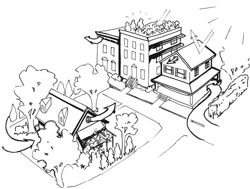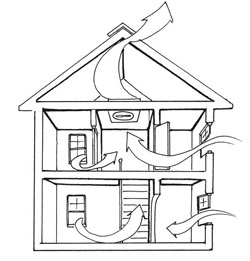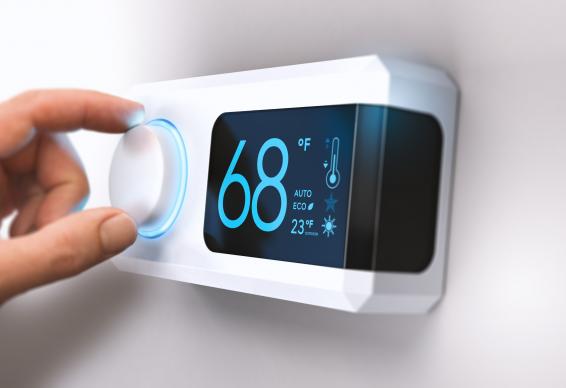More than three-quarters of all U.S. households have air conditioners. Energy consumption for home air conditioning accounts for more than 8% of all the electricity produced in the U.S. for all purposes, at a cost to homeowners of over $15 billion. That amount of electricity results in the release of roughly 196 million metric tons of carbon dioxide (CO2) per year, or an average for homes with air conditioning of close to 2 tons per year. A switch to high-efficiency air conditioners and implementation of measures to reduce cooling loads in homes can reduce this energy use by 20–50%.
As air conditioning becomes the norm in all regions of the country, it is important to realize that often the easiest and most affordable way to stay comfortable during the summer is to reduce your need for air conditioning. After discussing how to keep heat out of your house, this section covers different types of cooling systems, when to upgrade, how to select a new system, and what you can do to operate your existing system for maximum efficiency.
Reducing the Need for Air Conditioning
Information on how to reduce your cooling loads can be valuable to you whether you use an air conditioner or not. And even with the most efficient air conditioners, it makes a great deal of sense to do everything you can to reduce your need to use them. The following conservation measures are often so effective that houses in the northern third of the country and in mountainous regions can get by without air conditioning on all but the very hottest days. If you’re planning to buy a new system, reducing the cooling load will save you a lot of money right away by letting you buy a smaller, less expensive system.
Getting Rid of Unwanted Heat
There are three major sources of unwanted heat in your home during the summer: heat that conducts through your walls and ceiling from the outside air, waste heat that is given off by lights and appliances, and sunlight that shines through your windows. These are described below, along with techniques to reduce them.
Insulate and tighten your house. Whenever the outdoor temperature is higher than the indoor temperature, warm air will blow into the house through cracks. To reduce these gains, you can insulate and tighten your house. If you don’t have wall insulation, have cellulose, fiberglass, or foam blown into the walls by a qualified insulation contractor. Tighten up your house to reduce infiltration. You might also want to install a radiant barrier in the attic to cut down on summer heat gain. If properly installed, a radiant barrier can reduce cooling costs to some extent, particularly in the South. An energy auditor can help you decide which measures make the most sense for your house and how much they will cost (see Insulation).
Get Rid of Inefficient Appliances. Lighting, refrigerators, stoves, washers and dryers, dishwashers, and other household appliances are all sources of waste heat, raising the interior temperature of your house. The best solution is to buy energy-efficient products. Energy-efficient appliances and lights produce far less waste heat. Standard incandescent light bulbs, for example, emit 90% of their energy as heat — only 10% as light. Compact fluorescent lights, on the other hand, produce only a fraction of the heat (see Lighting). In some cases, you can delay heat-producing tasks, such as dishwashing, until the cooler evening hours. You might also consider relocating a freezer to the basement or garage, where it won’t contribute its waste heat to your living space. And by planning your meals carefully, you can minimize use of the oven on the hottest days.
Make “cool” choices when roofing or painting. Lighter colors tend to reflect more solar radiation from your house, cutting down the amount of heat penetrating the roof and walls. This may seem like a minor tip, but using “cool” products may lower roof surface temperatures by 50-60ºF and reduce your peak cooling demand by 10–15%. If you are replacing your roofing tiles or if your roof is black, look for shingles, coatings, and other roofing materials that have been rated for high “solar reflectance” and high “thermal emittance.” If your neighborhood has certain codes for roof tiling or if you are otherwise concerned about the aesthetics of a light-colored roof, look for new products on the market that use familiar dark pigments that have been engineered to conduct less heat.
Shade or improve windows. Sunlight shining in windows, particularly those on the east and west sides of the house, usually adds the largest amount of unwanted summertime heat. In addition, the sun heats up the roof and walls of the house, increasing heat conduction to the interior. With no shading of east and west windows, the interior temperature of a typical house could rise as much as 20°F on a hot day, either making your air conditioner work a lot harder, or making you a lot less comfortable.
The best way to eliminate solar heat gain is to provide effective shading. Use horizontal trellises above east- and west-facing windows, which collect more summer sun than the others. Plant tall trees (prune lower branches so as not impede summer breezes), or use awnings wider than the windows to provide shade. If you have a choice, place porches, sheds, and garages on east and west walls to provide further shading. Unless you have extensive areas of south glass, the south wall should not require summer shading because the summer sun is at too high an angle to cause much of a problem. Planting evergreen trees in front of south windows, however, will block beneficial winter gains.
If you’re replacing windows, put in high-performance windows with low-e glazings that look perfectly clear yet block out a large percentage of unwanted heat gain (see Buying New Windows). It makes sense to install windows with low solar heat gain coefficients (SHGC) on west and east walls, where heat gain from the sun is the greatest in the summer. Windows with high SHGC make more sense on the south walls, especially when you want to benefit from passive solar heating during the winter months. Another way to reduce solar gain through windows is to install drapes with light-colored linings or operable blinds that will reflect sunlight back outside. Vertical blinds are particularly effective on east- and west-facing windows. Also choose lighter colors for roofs and walls to reflect sunlight and reduce conductive heat gain.
Improving Comfort with Air Movement and Ventilation
Ceiling fans. Ceiling fans work to cool by creating a low-level “wind chill” effect throughout a room. As long as indoor humidity isn’t stifling, they can be quite effective. If your fan has a motor that can spin in either direction, you can use it to lower your energy costs all year round. During the summer, a counter-clockwise motion creates a breeze. In the winter, a clockwise motion creates an updraft that keeps warm air in the occupied space. The following table gives the necessary fan blade diameters for various size rooms. Fans should have multiple speed settings so that airflow can be reduced at lower temperatures. When shopping for a ceiling fan, look for the ENERGY STAR label.
ENERGY STAR ceiling fans provide more effective fan cooling with less energy by using improved blade design, offering more control options, and including high-efficiency light kits. If you already have a ceiling fan, make sure to adjust the blades when needed to minimize wobbling. You can also reduce the energy the fan uses by replacing the lighting component with one certified by ENERGY STAR. As an added bonus, these light kits require fewer bulb changes (see Lighting for more). Also, remember that fans cool people — they don’t actually reduce room temperature — so turn it off when you leave the room.
Window fans. Window fans for ventilation are a reasonable option if they are used properly. They should be located on the leeward (downwind) side of the house facing out. A window should be open in each room. Interior doors must remain open to allow airflow. Window fans can be noisy, especially on high settings, but they are inexpensive.
Whole-house fans. A permanent whole-house fan is a more convenient option than window fans, but will cost more than three or four window fans. Mounted in a hallway ceiling on the top floor, the fan sucks air from the house and blows it into the attic. The fan is usually covered on the bottom by a louvered vent. (To reduce heat loss through the fan during the wintertime, the entire assembly should be installed within an insulated, weather-stripped box with a removable or hinged lid.) If the attic is not closed off to the rest of the house, the best spot for a whole-house fan is right in the gable vent, the highest point in the house. The fan should have at least two speeds, with the highest one capable of changing the entire volume of air in the house very quickly. Because the fan blows air into the attic, the attic must have sufficient outlet vents. The attic free vent area, including soffit vents, ridge vents, and gable-end vents, should be twice the free vent area of the fan opening. (Free vent area is a measure of the area of the vent opening minus the area blocked by screening and louvers.)
Before turning on the fan, be sure to open several windows in various areas of the house. If just one or two windows are open, the airflow through them will be intolerably high. For safety reasons, the fan should have manual controls (either in addition to or instead of automatic controls). A fusible link, which automatically shuts the fan down in case of fire, should be included for safety (the controls should be installed by a licensed electrician). The fan should be installed carefully; a loose installation can cause vibrations and excessive noise. Units with low-speed motors (700 rpm or less) will usually be less noisy. Ask for a demonstration.
The whole-house fan can be turned on as soon as the outdoor temperature drops about three degrees below the indoor temperature, for example, in the evening. The fan speed should be adjusted according to how quickly you want to cool the house down. Mechanical ventilation uses far less electricity than mechanical air conditioning.








